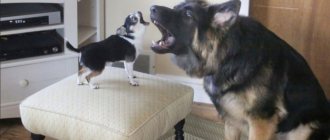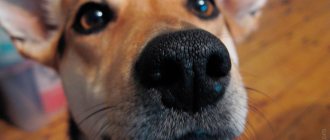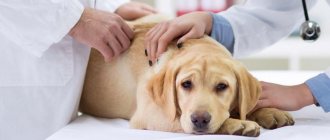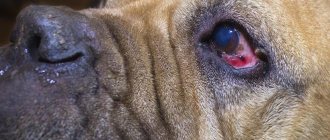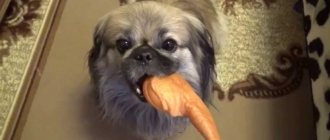Blindness in dogs
A condition that prevents light from reaching the retina of the eye impairs the animal's vision. Examples of such conditions include cataracts, uveitis and glaucoma. However, in addition to the above diseases, there are many reasons that can provoke complete or partial loss of vision in a dog. Among them are age-related changes. This, however, does not mean that all older dogs will certainly go blind. Such negative vision dynamics are strictly individual and depend on many factors.
Critical vision loss due to cataracts in dogs
Cataracts in dogs are clouding of the lens of the eye, accompanied by decreased vision up to complete loss of light perception. The lens is an indispensable element of accommodation of the eyeball. It looks like a biconvex lens, is located in the recess of the vitreous body, loosely adjacent to it and forming a capsule. With age, the lens tissue thickens and becomes less elastic. Either myopia or, most often, farsightedness develops. Also one of the most common diseases of the lens is cataract.
Symptoms of partial or complete vision loss
A general examination of a dog's eyes very rarely reveals the cause of blindness. But there are common symptoms of decreased vision in dogs. A pet suffering from a visual impairment walks extremely carefully, fearing that it will bump into an object; however, sometimes a collision cannot be avoided. This is an extremely alarming sign of incipient blindness. Also, with complete or partial loss of vision, the dog usually lowers its muzzle lower to the ground. It is also possible that certain disturbances in the animal’s motor activity may occur. At the same time, the dog loses the ability to catch objects or food thrown up. Often such changes are age-related. However, in most cases they are caused precisely by a serious decline in the dog’s vision.
Below in the video you will see how a blind dog behaves during games.
Medicines for inflammation of the cornea (keratitis) in dogs
Inflammatory processes in the dog’s body can provoke clouding of the cornea, which can lead to complications in the form of abscesses and ulcers, leading to perforation of the cornea if the disease progresses unfavorably.
The damage to the cornea that occurs is replaced by connective tissue, resulting in the formation of a cataract (an opaque whitish spot) on the eye.
Effective treatment of an eyesore in a dog is possible only in a veterinary hospital.
In rare cases, spontaneous restoration of corneal transparency is possible due to resorption of the infiltrate.
It is customary to divide inflammation of the cornea of the eyes (keratitis) in dogs into:
- superficial purulent;
- deep purulent;
- superficial vascular;
- catarrhal;
- phlyctenulosis;
- point;
- superficial.
To treat keratitis, antibiotics, ointments or drops of hydrocortisone, and sulfonamides are used.
Accumulations of pus in the conjunctival sac are removed using solutions of penicillin, furatsilin, boric acid, furagin, ethacridine lactate.
At the stage of attenuation of inflammatory processes, the resorption of corneal opacities is artificially stimulated using tissue therapy, treating the cornea with yellow mercury ointment, dionin (from half to five percent solutions) or novocaine blockades.
Other drugs (acyclovir, solcoseryl, ophthalmic polymer films, dexamethasone, sofradex, betnesol, etc.) have also proven their effectiveness in the fight against the disease.
To avoid complications, the use of all of the above medications is permissible only with the agreement and approval of a veterinarian.
Diagnosis of blindness in a dog
There are the following methods for diagnosing blindness in dogs:
- Using bright light. This method allows you to determine whether a dog is blind based on a study of the pupil's reaction to light. If the pupil does not constrict, the dog is blind. If narrowing does occur, there is a chance that vision is not completely lost. However, this test is not one hundred percent accurate, so it is not enough to make a correct diagnosis.
- Placing the pet in a room with the lights off. Before performing this test, you should move the furniture in the room. It is worth paying attention to how the animal moves, whether its movements have become less confident and its trajectories more blurred. Then you need to turn on the light and repeat the experiment. A blind dog will not change its behavior. A dog with poor eyesight will move much more confidently.
- Testing the dog's reaction to a threat. A sudden threatening gesture will help determine the state of vision of your four-legged friend. If there is no reaction, the dog does not recoil or even blink - this is a sure sign of blindness.
- Obstacle course. Running an obstacle course can also help determine your dog's vision. However, before conducting such an experiment, the specialist must make sure that a healthy animal can overcome such a test.
- Ophthalmoscopy.
- Schrimer's tear test. This test is usually used to diagnose keratoconjunctivitis.
- Taking samples for bacteriology, cytology and mycology.
- Determination of nasolacrimal patency.
- Application of ultrasound.
- Measuring intraocular pressure.
- Gonioscopy and electroretinography.
Some of the above methods for diagnosing blindness can be applied at home. If, as it seems to you, the fears are confirmed, the dog should be taken to a veterinarian, who, in turn, will conduct all the necessary tests.
Medicines to treat conjunctivitis in dogs
Large breeds of dogs - Great Danes, Dobermans - are more often susceptible to diseases associated with inflammation of the conjunctiva (conjunctivitis).
The causes of the disease are extremely varied: from a banal lack of minerals and vitamins in the animal’s body (vitaminosis) and allergies to serious injuries or severe infectious diseases like piroplasmosis or plague.
The conjunctiva also becomes inflamed due to external chemical influences - alkali, acid, aggressive drugs, lime, as well as foreign bodies entering the eye.
The cause of conjunctivitis can be the transfer of inflammation from adjacent areas of the skin.
The selection of medications to rid a dog of conjunctivitis depends on (1) its type (catarrhal, purulent, allergic, phlegmonous, follicular, etc.), which can only be diagnosed by a professional veterinarian, and (2) the causes of the disease.
For example, purulent conjunctivitis requires loading doses of antibiotics, the use of penicillin, synthomycin, tetracycline ointments and 30 percent albucid.
To treat catarrhal conjunctivitis, drip preparations with astringent properties are used (hydrocortisone, alum, one to two percent solution of zinc sulfate or protargol, resorcinol).
For follicular conjunctivitis, ophthalmic polymer films with sodium sulfapyridazine or kanamycin in combination with a conjunctival cauterization procedure performed in a veterinary hospital are considered an effective treatment.
To remove pus accumulating in the conjunctival sac, use a three percent solution of boric acid, rivanol (ethacridine lactate) in a concentration of 1 to 2000, or furatsilin (1: 5000).
For uncomplicated forms of the disease, the following medications are effective:
Treatment of blindness
It is important to remember that vision loss is not the end. You should not fall into despair, much less think about euthanasia in order to alleviate the suffering of your pet. Even an animal suffering from blindness can live a rich and full life. You just need to support your pet and show him that you do not love him less. Additionally, most dogs don't see that well, even though they don't suffer from vision problems. The main senses that our four-legged friends rely on are smell and acute hearing. Reduction or loss of vision leads to an exacerbation of the above senses, which allows the animal to function quite normally. This, however, does not mean at all that a blind dog can be released into an unfamiliar area - this can lead to injury.
Also, you should not do home renovations. If you can’t avoid it, try to rearrange the furniture to a minimum. Otherwise, the dog may be completely disoriented. If you find out that your dog has poor eyesight, do not let him go far from you while walking.
You should not “make the life of a pet suffering from blindness easier” by moving him to the necessary places. He needs to learn to move on his own. Try to come up with special games that would develop the animal’s hearing and sense of smell.
If you notice that your dog is beginning to lose his vision, you need to gradually prepare him for possible blindness. Try to train your pet's reaction to certain commands. If a dog does go blind, in certain situations, obedience and following commands can save its life.
If there is another animal in the apartment or house, there is a high probability that they will begin to take care of the injured friend, thereby greatly facilitating the owner’s task.
What medications should I give my dog for other eye diseases?
The format of the publication does not allow us to dwell in detail on the description of methods and medications for all eye diseases and injuries in dogs without exception.
Taking into account the demand for this or that information, we suggest that you familiarize yourself with the following table, which gives an idea of the variety of certain medications used by modern veterinary medicine to treat the corresponding eye pathologies.
As we accumulate materials, we plan to post additional articles that expand or clarify certain provisions set out in this publication.
Table 1. Medicines used to treat eye diseases in dogs
source
How can you tell if your dog is going blind?
Blindness is a terrible disease. It has a big impact on your pet's quality of life. Losing vision, of course, is not a death sentence. Animals and their owners adapt to changing circumstances and learn to live in a new way. Blindness does not fall out of the blue: yesterday you were sighted, but today you are not. Of course, cases are different, but most often dogs lose their vision gradually, the process is significantly extended over time. And it is very important for the owner to catch warning signs and symptoms.
Firstly, the sooner you suspect something is wrong, the better - your pet will be examined by a veterinarian and an accurate diagnosis will be made. Perhaps our vision can still be restored! Secondly, you all need a difficult adaptation period. If you can’t help the animal, then at least you need to learn to live with this terrible disease! So how can you spot an impending problem?
Changes in the appearance of the eyes. As a rule, they are clearly visible and distinguishable: dragging, spots, opacities, changes in the color and shape of the pupils, various types of neoplasms that were not previously noted. It should be noted that sometimes no visible changes are detected. Our advice is this: look at what your dog's eyes look like right now. Remember. And check from time to time!
Strange eye movements, lack of coordination. In a healthy dog, both eyes work “in sync.” Have you ever been to an ophthalmologist? The doctor probably asked you to follow the movements of his finger with your eyes. At the same time, both your eyes concentrated and simultaneously looked towards the “selected” object. Provided, of course, that everything is in order! It's about the same in dogs. It also happens that each eye lives its own life; There is no coordination in eye movements. It happens that when a finger approaches, the eyes (or both eyes) suddenly begin to twitch in a spasm. Warning symptoms to watch out for!
Reaction to bright light. A good way to test your pet's vision! In both humans and dogs, the pupils react instantly to sudden changes in light. Have you walked out of a dark room into bright light? The pupils quickly shrank. On the contrary, did you enter a shadowed room from the light? The pupils dilated. Try it with your dog! The animal’s pupils did not respond to changes in illumination or the pupils did not constrict or dilate at the same time - this means problems are looming.
Problems with vision in certain conditions. For example, in low light conditions. Your dog may become noticeably confused in the twilight, but in normal lighting he can see as if normally. The method is not one hundred percent reliable - each dog has its own individual characteristics. But you still need to check.
The dog has difficulty distinguishing objects in direct visibility. At the same time, everything is in order with peripheral vision (when the dog sees objects located on the sides). How can you tell if your pet relies on peripheral vision? He noticeably squints when he looks at things and objects located directly in front of him. Or he turns his head to get a better look at the objects that interest him.
The dog bumps into things and objects in the apartment. Most often this happens in relatively unfamiliar areas - for example, immediately after moving to a new house or apartment. The fact is that dogs are very observant; they are perfectly oriented in familiar rooms even without the help of vision. And yet - if such “incidents” occur day after day, then we are dealing with alarming symptoms!
Lack of clear perception of moving objects. Usually dogs react quickly and acutely to moving and moving objects. For example, throw a ball! The dog will rush after him and catch him. We're talking about a healthy animal, of course! Well, if your pet remains indifferent to the thrown ball, it means that his eyesight is failing him (in most cases this is true).
The importance of regular preventive examinations. Don't neglect these important procedures! Be sure to visit the veterinarian once a year, even if your dog looks completely healthy. In our article, we indicated only the most characteristic, general symptoms. But a professional specialist has his own tools! You may not pay attention to something truly serious at all, you may miss it. Not a single detail will escape the eye of an experienced veterinarian!
Some dog breeds are even predisposed to vision problems, such as progressive retinal atrophy. Is your breed of dog at risk? Then visit your veterinarian even more often. The specialist will definitely prescribe additional tests and screenings. It is better to identify any disease in the initial stages!
A dog owner should suspect that something is wrong if the following symptoms occur:
- The dog begins to bump into pieces of furniture or other objects more often, even in a familiar/familiar environment;
- Does not immediately find favorite toys, even if they are in sight;
- There is stiffness, awkwardness, clumsiness, reluctance to move, excessive caution when moving;
- During walks, the dog sniffs everything all the time, moves with its nose buried in the ground, as if following a scent;
- If the dog knew how to catch balls and frisbees, but now misses more and more often;
- Does not immediately recognize familiar dogs and people on a walk;
- Sometimes the first symptoms of vision loss can be noticed at a certain time of day: for example, the dog is clearly less able to navigate at dusk or at night;
- The dog may experience excessive anxiety or, conversely, depression;
- With one-sided blindness, the dog can only bump into objects located on the side of the blind eye;
- You may notice changes in the width of the pupils and the transparency of the cornea, redness of the mucous membranes, lacrimation or dryness of the cornea.
Blindness in dogs - causes and manifestations
Sense organs are the most important tool for survival under conditions of natural selection. Domesticated animals live longer than wild ones, thanks to the care of their owners, but this has a “downside” - diseases, sometimes lifelong and irreversible. Blindness in dogs is a serious illness for a pet and a death sentence for a stray animal. It is almost impossible to predict a congenital abnormality or its development, however, it is necessary to know and be able to interpret the signs of vision loss.
Medicines for eyelid injuries in dogs
The scope of medical care for eyelid lesions (Vulnus palpebrae) depends on the severity and nature of the disease or external injury.
Photo 1. Novocaine solution is most often used for pain relief for serious eye lesions in dogs
Severe physical damage to this organ, accompanied by cuts or tears in the tissue, requires immediate surgical intervention, usually accompanied by suturing.
A one to two percent solution of novocaine is most often used as an anesthetic.
To prevent the spread of infections, it is advisable to use antibiotics (exclusively as prescribed by a doctor), and as a means of disinfecting the cuticle of the eyelid and adjacent areas of the skin - “brilliant green” (a one percent solution of brilliant green).
In all cases of violation of the integrity of the eyelid, the first task is to rinse the wound with warm water and remove dirt deposits. The next step is to take the animal to the nearest veterinary hospital.
Causes of blindness in dogs
Any disease, injury, or developmental disorder that completely or partially blocks light from reaching the retina of the eye results in blindness. The eye is a complex structure, a fairly autonomous organ with its own protection tools. Considering that the eyeballs are directly connected to the brain, there are three main causes of blindness:
The brain perceives information in the form of nerve impulses, so that the dog can see, the following algorithm must occur:
- Rays of light strike an object and are reflected from it.
- Reflected light rays pass through the cornea, anterior chamber of the eye, pupil and vitreous body.
- Refracted and scattered rays fall on the retina, an organ consisting of receptors (rods and cones), which convert the light signal into a nerve impulse.
Note! In fact, the process of reproducing an image takes less than a second, while the brain has time to “weed out” unnecessary information.
What medications should I give my dog for eye diseases?
The purpose of today's publication is to review the most common and effective medications used by professional veterinarians and amateur dog breeders to treat eye diseases in dogs.
Due to the abundance of reasons that can cause eye pathologies in pets, we will deliberately limit ourselves to a fixed list of diseases from which they most often suffer: injury to the eyelids, inflammation of the eyelids, corneas, conjunctiva and a number of others.
We will devote much more substantive and detailed publications to individual eye diseases in dogs with a detailed description of their etiology, symptoms, methods and means of treatment.
The names of medications, their dosages and conditions of use for the treatment of eye diseases in dogs are borrowed from textbooks and authoritative scientific works on veterinary medicine.
How to identify blindness or decreased vision in a dog
A standard veterinary examination will not detect most disorders that affect visual acuity. You may notice signs of vision loss by observing your pet in everyday life:
- The dog moves unsteadily, especially if pieces of furniture are not in the same places.
- When going down or going up the stairs, the ward throws his paws high or stumbles.
- The pet refuses active games and fetch, and avoids other dogs, especially those with which confrontations may arise.
- During walks, the animal keeps its head tilted to the ground most of the time.
- There may be problems with the perception of commands given by gestures.
- A deconcentrated gaze is observed (the dog looks through objects).
One method to detect blindness in a dog is a dark room test. Several obstacles are placed in a small room, after which the lights in the room are turned off. An animal found in an unfamiliar environment will rely on smell and touch, and only then on vision. Observe whether the student will bump into obstacles or be able to get around them. Turn on the light, if the dog cannot see, it will move along the same route, the sighted animal will noticeably perk up and behave more confidently.
Congenital blindness in dogs is rare and is diagnosed at 6–8 weeks of age. Only a veterinarian-ophthalmologist can accurately determine blindness in puppies; you can do the following tests yourself:
- A large piece of cotton wool is tied to a thread. When the puppy is not doing anything, you need to stand in front of him and swing the cotton wool in the air. If you observe eye movement or a more pronounced reaction, the baby sees.
- Use a laser pointer or flashlight. Direct the beam to your pet's front paws and observe the reaction.
- Reaction to a threat - cover one of the animal's eyes with a bandage and make a sharp gesture with your hand towards the dog's muzzle. The target must blink and duck. Repeat the test with the other eye.
Important! Even the unimpaired vision of dogs is not particularly sharp. To navigate in space, the dog uses a keen sense of smell and hearing, so vision tests should be carried out in complete silence and with odorless stimuli.
How to properly treat cataracts in a dog?
Treatment of cataracts in dogs in the early stages is in most cases conservative. The following types and groups of drugs are used:
- Vita ioduroltriphos adenine drops in a dosage of 1-3 drops 1-3 times a day, depending on the size of the dog and the stage of the cataract,
- Vicein drops in a dosage of 1-2 drops 2 times a day for a long time,
- Drops with vitamins B, C, PP, A, E. These vitamins slow down the development of cataracts and saturate the eye tissue with essential nutrients. They are used in accordance with the instructions.
- Preparations of ascorbic acid, riboflavin, beta-carotene orally according to the dosage regimen.
- Calcium and phosphorus preparations orally and in the form of intravenous and intramuscular injections or in the form of drips.
Physiotherapeutic devices and devices have recently been widely used in veterinary ophthalmology. In the early stages, the disease is treated with courses of physiotherapy; one session lasts 10-15 minutes, is carried out daily or every other day, the course lasts 7-14 days, sometimes 21 days, and is repeated every 3-6 months.
Treatment with traditional methods
Traditional methods - homemade honey and onion drops diluted with warm boiled water - help support the dog's eyes, nourish them and cleanse them. Liquid honey is slightly melted, diluted with warm water, filtered and used. The juice is squeezed out of the onion, also diluted with water and filtered. You can store homemade drops for several days in the refrigerator, warming them slightly before instillation. Due to the risk of developing an allergic reaction, the use of such drops should be agreed with a veterinarian.
Medicines improve blood supply to the eye, trophism of the lens, and stabilize metabolism in the tissues of the eye. They also prevent the deposition and accumulation of cholesterol, lime, salts, and other undesirable substances and their compounds in the eye, and improve regeneration processes.
It must be remembered that drug treatment only delays the maturation of cataracts and, accordingly, surgical treatment, but does not cancel further surgical intervention.
In advanced cases, treatment of cataracts in dogs is carried out surgically. The veterinarian prescribes tests for the dog, and sometimes a heart examination. Cataract surgery is usually planned and performed at the appointed time. The animal is taken to the clinic, premedicated, anesthetized, and surgery is performed. After the operation, the dog is under the supervision of medical staff. Large clinics have designated operating days. This is very convenient, since the staff working with surgical patients is not distracted by the current appointment.
The operation cannot be performed if the dog is diagnosed with an inflammatory or purulent-inflammatory eye disease simultaneously with cataracts: conjunctivitis, blepharitis, dacryocystitis, keratitis. First you need to cure the concomitant disease.
Diseases that cause blindness in dogs
Animals suffering from visual impairment are not allowed for breeding; please note that when purchasing a puppy, you have the right to request a document confirming the health of both parents. Night blindness in dogs is a disease that is inherited, including through one or several generations. The course of the disease can be expressed in partial loss of vision in the light or in the dark, complete blindness from birth or due to the progression of the disease. A dog is born sick if both its parents have a damaged gene - this is confirmed by a DNA test.
Increased intraocular pressure (glaucoma) is the most common cause of vision problems in young pets. The problem is that the disease proceeds covertly until the “critical moment” occurs; often, sudden blindness in dogs is a consequence of glaucoma. Treatment of the abnormality depends on the root cause of the disease; usually, the veterinarian prescribes complex symptomatic treatment - drugs that lower blood pressure, increase blood flow, and prevent the formation of blood clots.
Detachment or atrophy of the retina due to hormonal disorders and overactivity of the thyroid gland occurs with diabetes mellitus or adrenal dysfunction. The atrophy process can be stopped, but it is impossible to restore lost vision without surgical intervention.
New growths in the brain or eyeballs place direct physical pressure on blood vessels and nerve endings. Blindness can be a symptom or complication of a nervous disorder due to damage to parts of the brain. Often, vision loss is temporary and reversible. For example, a dog may become partially blind after epilepsy or a stroke, but with proper treatment, vision can be restored.
Manifestations of cataract disease in dogs
Cataracts are the leading cause of blindness in older and older dogs. As in humans, this disease is gradually getting younger and is increasingly being diagnosed in young animals. It even happens that cataracts are found in very young puppies. In this case, they speak of either congenital cataracts or early acquired atypical ones.
The disease manifests itself as follows. The transparent layers of the lens are slowly interspersed with cloudy layers. The appearance of the first few layers goes unnoticed. To look at something, the dog simply turns its head to bring the object into focus. Animals with absolutely normal vision do this, so the owner usually does not pay attention to it.
Over time, the intensity of the clouding increases, and visual acuity decreases. The dog loses his vision gradually, so he has time to adapt to the situation. In addition, dogs rely more on their sense of smell and hearing than on their vision, so they do not experience such acute discomfort due to loss or decrease in vision as is typical for humans. As a result, it can be difficult for an owner to detect signs of decreased vision in a pet, since in the early stages of cataracts the dog's behavior does not change significantly.
As the cataract matures, the lens thickens, the refraction of rays changes towards intensification, which is why myopia develops. The dog cannot see in the distance. This becomes especially noticeable in hunting dogs, which can no longer pursue game “with their sight.” Myopia also affects the quality of work of sports dogs: they do not see the command gestures of the handler in the ring, do not notice projectiles on unfamiliar paths, and miss when catching a Frisbee disc. In a decorative breed dog, chain or kennel dog, myopia remains unnoticed until the cataract passes into the final stages with the formation of spots resembling a cataract.
How does the disease progress?
Over time, vision decreases to simple light perception. The back layers of the lens become cloudy, but the top layers remain transparent for some time. Then cloudiness is observed throughout the lens.
If the central part of the lens becomes cloudy, twilight vision is maintained or even briefly improved, but daytime vision is greatly deteriorated. In bright light, the pupil narrows, the light ray is retained in the cloudy part of the lens. In dim lighting, the pupil dilates and the beam passes unhindered through the unclouded part of the lens. Vision deteriorates faster the closer to the center of the lens the clouding center is located.
Turbidity appears first in the form of stripes, then the stripes expand and gradually merge into a single focus. Over time, the pupil closes completely. The lens increases in volume, the anterior chamber, on the contrary, decreases, and intraocular pressure increases. Cataracts, in the absence of timely and adequate treatment, are often accompanied by glaucoma, which threatens complete and irreversible loss of vision.
When the opacification involves the cortex, canine cataracts are considered mature. This stage is considered the most suitable for surgical treatment. If the cataract is overripe, then either the lens gives off fluid, and lime and cholesterol are deposited in the anterior chamber, or the cortical substance liquefies. This condition requires immediate surgery, but maintaining vision at this stage is difficult. Sometimes it is even difficult to preserve the eyeball in severe or complicated cases of the disease.
Causes of blindness:
A) The most common is considered to be traumatization. Especially when the apartment contains a cat and a dog. Cats with their claws injure the cornea of the dog's eye, and if you do not consult a specialist in a timely manner, the dog may partially lose vision.
B) Eye infections (mycoplasmosis, chlamydia, staphylococcus, toxoplasmosis, brucellosis). Simple conjunctivitis can lead to inflammation of all the membranes of the eye (panophthalmitis) and complete loss of vision.
B) Viral infections (feline FIP, herpes virus, canine distemper)
D) Diseases of internal organs (with kidney and heart pathologies). There is an increase in intraorbital pressure and, as a result, blindness.
D) Age-related changes (cataracts, glaucoma).
E) Inflammation of the optic nerve
H) Congenital developmental anomalies (dystrophies)
Life with a blind dog
Many volunteer organizations actually strive to help blind and visually impaired dogs.
If you have a blind or visually impaired dog, you can contact these organizations for advice. Here are some helpful tips to get you started:
- Place tags or bells that ring or make noise on other animals in the house—and consider putting them on yourself—so your blind dog knows where family members are.
- Teach your dog commands such as "look" so he knows he is approaching an obstacle. Also consider the "steps" command to teach him when there is a step in front of him.
- Get down to the level of your dog who has low vision or is blind to look for things in your home that could cause injury. For example, sharp table corners.
- Help create routes for your pet
- from bed to food, the front door and his favorite place to sleep. Keep these routes free of any obstructions to make it easier for him to walk. When you take your pet outside, you may have to keep him on a leash to guide him to his favorite places to do his business. After some time, his other senses will strengthen and help him in this habitual behavior. - Help him stay active. Just because your dog is visually impaired doesn't mean he can't have fun and play. Just as a guide dog would be suitable for a person with a visual impairment, you can help lead the dog along with a leash.
- Make sure the leash is short so you can better tell him where to go. It's also fun to let him sniff and smell his surroundings. It's a small gesture, but he'll definitely appreciate it. You can also help him play. Find an open, safe place for him to run around the backyard and play with dog toys that make noise. Through his sense of smell and hearing, he will eventually be able to track the ball, and when you call him, he will use those same senses to return to you.
There is no doubt that caring for blind dogs will require special efforts.
But with love and time, you both can adapt to this natural state.
Just because your dog can't see like he used to, doesn't mean his quality of life has to suffer. Keep showing him the same love and affection that you always have and he will be forever grateful to you. ^Top


